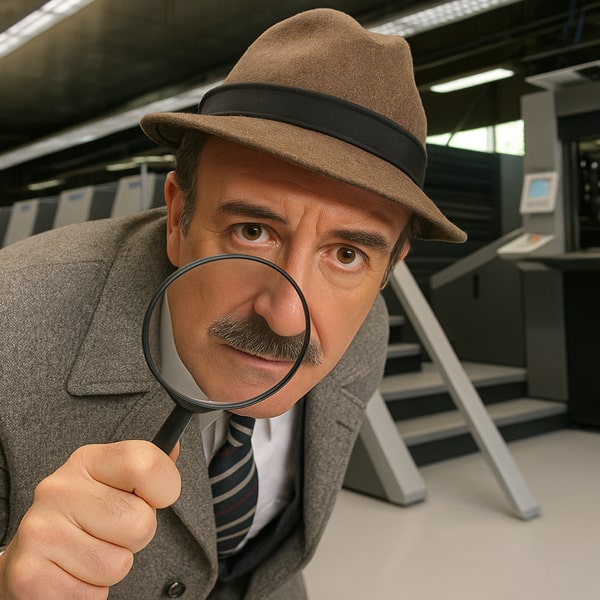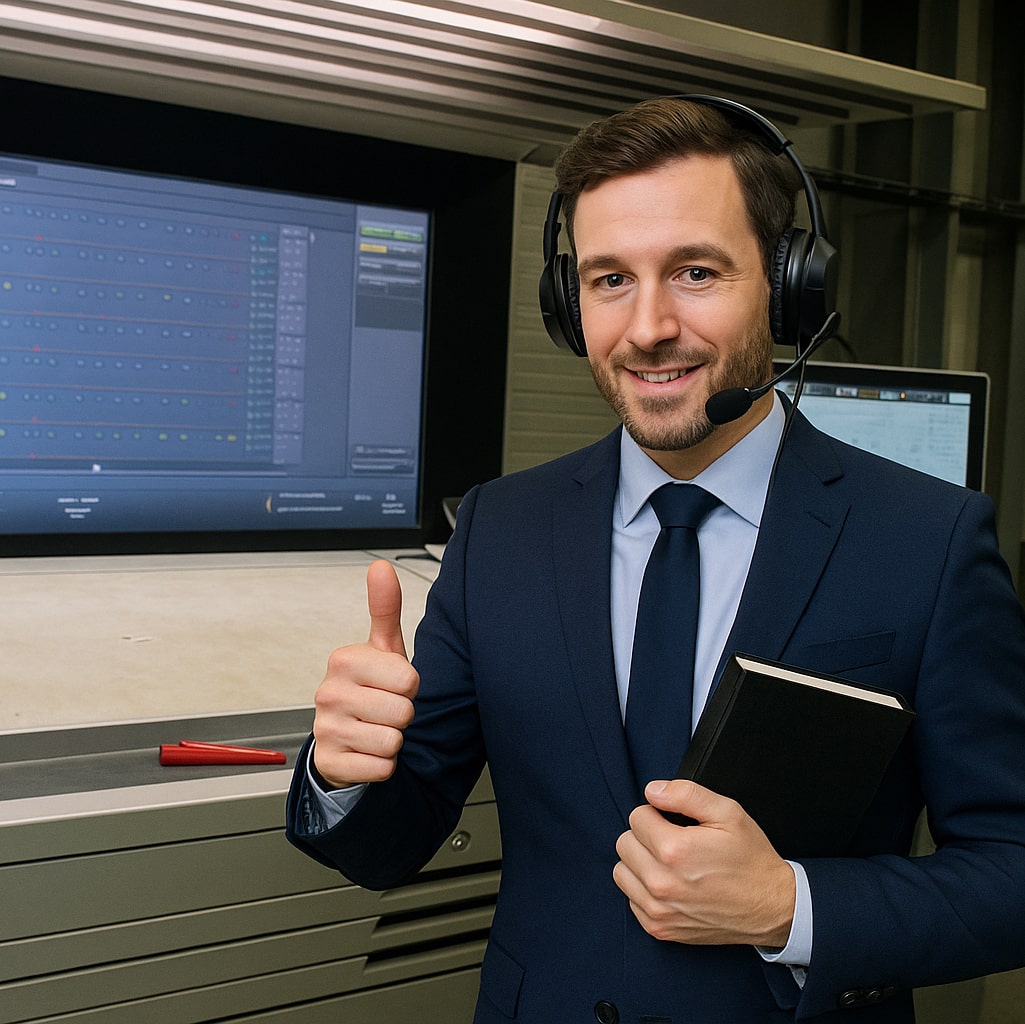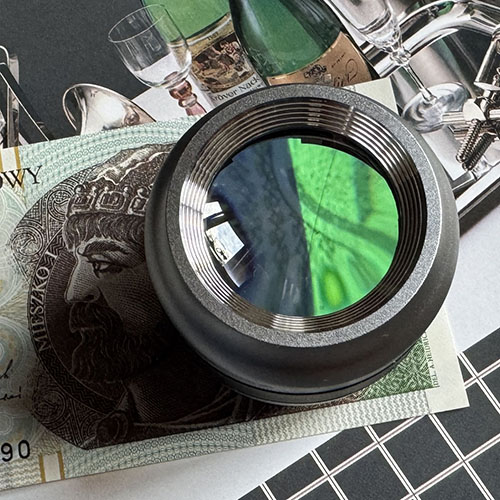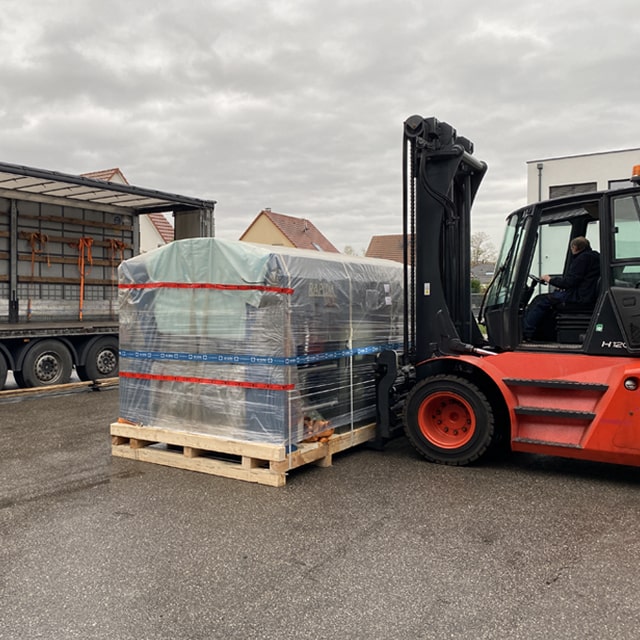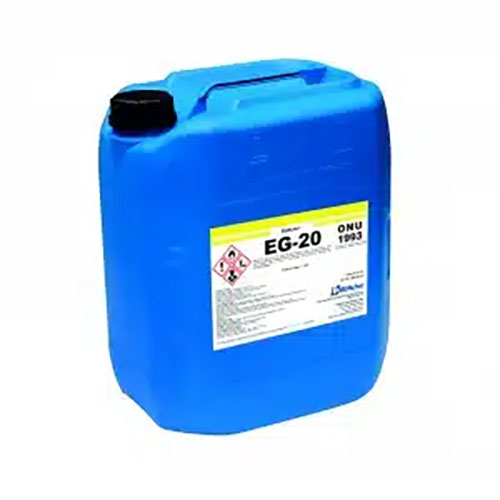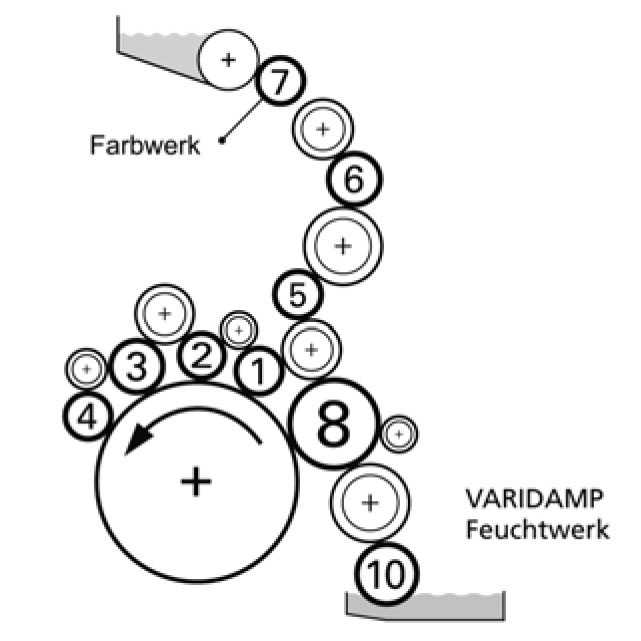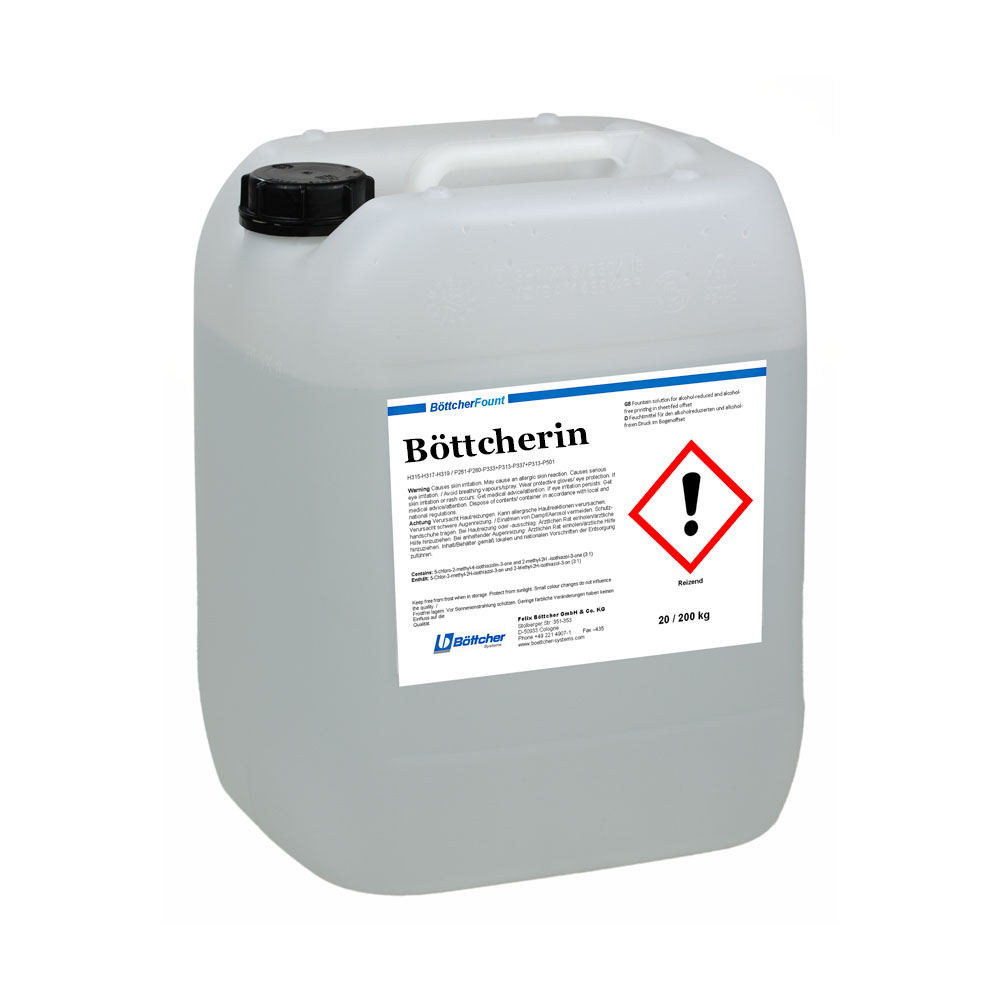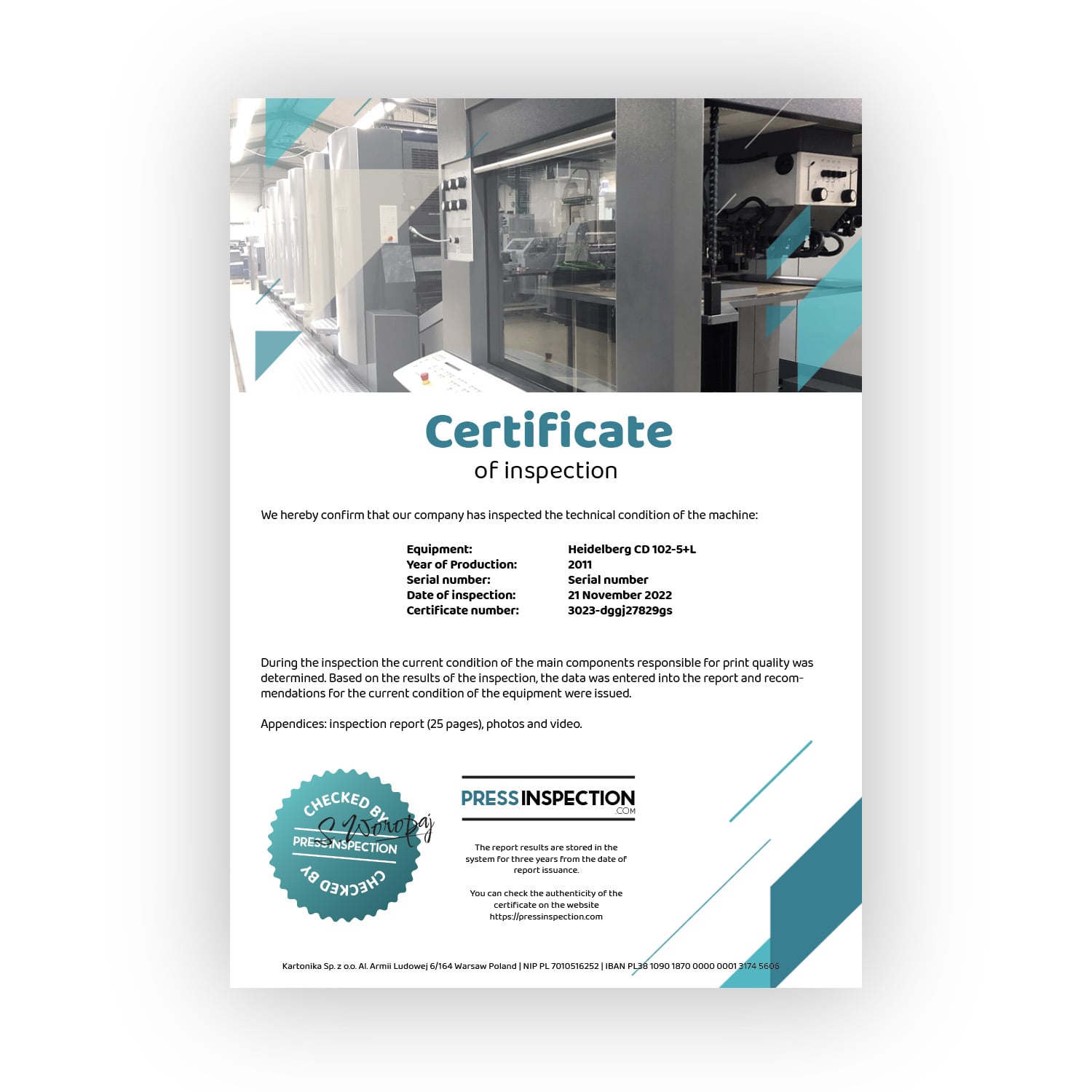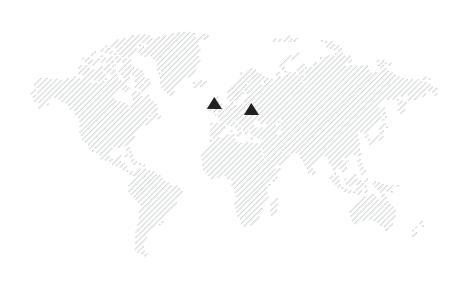Comprehensive Technical Evaluation Of Printing Machines
Over 35 years of practical experience in the printing industry.
WE ARE EXPANDING!Good news! We are working on a new version
of PressInspection.com
During the upgrade, we are temporarily closing our store. Optical devices are available through Allegro (Poland, Czech Republic, Slovakia).
If this service is not available in your region, please contact us via the contact form and we will send you an invoice for payment.
There Are Many Vendors, But Few Real HelpersIndependent Expert Support For Printing Companies
There Are Many Vendors, But Few Real HelpersIndependent Expert Support For Printing Companies
Independent technical inspections of used sheetfed offset presses — Heidelberg, KBA, Komori, Man Roland and others.
We verify mechanical and electronic condition before you buy, providing a full diagnostic report with photos and recommendations.
One-hour expert consultation via Zoom or Google Meet to help you choose the right sheetfed offset press for your production.
Based on 35+ years of experience, we offer an unbiased market overview and guide you toward the most reliable models.
Supply of original and compatible pressroom consumables — Boettcher rollers, wash-up blades, offset chemicals, and accessories.
We help printshops maintain consistent quality and reduce downtime through reliable, tested materials.
Professional dismantling, transport, and installation of sheetfed offset presses across Europe.
We coordinate every stage — from mechanical disassembly to precise alignment and print test after reinstallation.
Independent technical inspections of used sheetfed offset presses — Heidelberg, KBA, Komori, Man Roland and others.
We verify mechanical and electronic condition before you buy, providing a full diagnostic report with photos and recommendations.
One-hour expert consultation via Zoom or Google Meet to help you choose the right sheetfed offset press for your production.
Based on 35+ years of experience, we offer an unbiased market overview and guide you toward the most reliable models.
Supply of original and compatible pressroom consumables — Boettcher rollers, wash-up blades, offset chemicals, and accessories.
We help printshops maintain consistent quality and reduce downtime through reliable, tested materials.
Professional dismantling, transport, and installation of sheetfed offset presses across Europe.
We coordinate every stage — from mechanical disassembly to precise alignment and print test after reinstallation.
OUR CHOICE FOR MODERN PRINT SHOPMeasuring Equipment
Suitable not only for printing houses, but also for numismatists, bankers, philatelists, and many other professions. We are confident in it because we use the equipment for our daily work.
OUR CHOICE FOR MODERN PRINT SHOPMeasuring Equipment
Suitable not only for printing houses, but also for numismatists, bankers, philatelists, and many other professions. We are confident in it because we use the equipment for our daily work.
VeriDoc Mini, A Magnifying Glass, White + UV 365
AVAILABLE NOW
FROM 75,00 €
DIGIMAG1, A Digital Round-screen Magnifier
AVAILABLE NOW
FROM 190,00 €
Bag For DigiMag: A Storage And Carrying Case
PRE-ORDER
UPON REQUEST
Request For Inspection Cost
Find hidden problems in the used printing machine you are planning to buy. It’s better to do this during the selection phase than when ownership of the equipment passes to you.
Let’s calculate the cost of your peace of mind by filling out the form.
Printing Consumables,
Spare Parts & Accessories Online
-
EG-20 De-Glazer For Blankets
47,39 € – 643,25 €
Select options
This product has multiple variants. The options may be chosen on the product page
-
EG-20 De-Glazer For Blankets
47,39 € – 643,25 €
Select options
This product has multiple variants. The options may be chosen on the product page
Insights for the Printing Industry
Would You Want To Buy Something Like This?
Extensive Experience
Operative Response
Problem Diagnosis
Multilingual Services
Flexible Support
An Objective Way To Avoid Problems
An Unwilling Traveller
In its long life, a popular used printing machinery like Heidelberg CD 102 or CD 74 changes several owners. Like a traveller, it may visit different countries or even continents. We cannot know how the previous owners dismantled the machine or how it was transported. Every disassembly and subsequent reassembly of a printing machine is a serious stress on the machinery.
I remember a Heidelberg CD 74 machine where the floor reinforcement was not made all around the machine. The machine was standing correctly, but its delivery would bounce when the speed was increased. Excessive vibration led to spontaneous loosening of nuts and uneven wear of gears!
Needless to say, this error leads to increased wear and tear on any machine, regardless of the manufacturer. No matter whether it’s a Heidelberg CD 102 or even Manroland Evolution, an incorrectly installed new machine quickly becomes a wreck. The owner thinks he got an unreliable machine and should look for an excellent Heidelberg XL 105, for example, which is sure to be more reliable.
Once the decision to sell is made, the owner usually stops investing in its condition. The equipment may be on the market for six months, or even longer. All this time, the machine is still holding up thanks to the reliability of the brand and the care of the staff.
When considering offers to buy offset printing machines on the secondary market, a buyer has to understand how much this machine deserves to be bought.
And that’s where the buyer comes in…
The key point before buying a printing machine is to assess its technical condition. Obviously, it is impossible to carry out a complete diagnosis of all assemblies, units, peripherals in a few hours. This would require several days and the availability of specialised equipment. In addition, prolonged shutdown of a printing machine in a print shop is not possible for commercial reasons.
So, what’s a buyer to do if they have a couple of hours to inspect a printing machine? All he can do is check the equipment visually, or with a printed test obtained from the internet.
But the problem is 99% of the tests that a potential buyer brings with him are intended to control the parameters that lie in the field of technology (control of dot gain, SLUR/doubling, trapping, streakmarks), etc. and are not an objective factor in assessing the technical (in particular, mechanical) condition of the printing press.
These printing of these control elements will tell you a lot about the technological process in a particular printing house, about the humidity conditions, about the selected inks and the qualification of the printer, but not about the real condition of the sheet-fed system of the printing machine.
Would a potential buyer be able to identify indirect equipment problems, such as those related to the flooring of a print shop?
Everything has been invented long ago
Definitely not – the customer will see no more than 30 per cent of what our expert will notice. Whether you are buying a Heidelberg CD 102, Manroland 700 or KOMORI Lithrone, compared to the potential costs of fixing problems, our inspection will require minimal time and money. This will allow you to make an objective assessment before you buy. We start by assessing the condition of the cylinders and the sheet transfer unit. It is very important to determine the condition of the sheet feed system on machines with a sheet perfecting module like the Heidelberg SM 102-8-P. In case of hidden problems, it is very difficult and expensive to repair.
The Heidelberg service manual clearly states: the operator must turn the perfector back and forth at least once every fortnight. When trying to shift a mechanism clogged with a mixture of paper dust and oil, it can easily be broken. Many printers ignore this. And for a new owner, it can be a serious problem.
Traces of previous dismantling also matter. We have encountered situations where negligent service technicians have lost the calibrated plates that set the distance between sections. If the Heidelberg SM74 machine is dismantled into parts of 2 printing units, the Heidelberg CD74 or XL75 is disassembled unit by unit. The loss of one of the plates can lead to uneven installation and damage to the gears. The machine will soon no longer hold register.
In addition, the condition of peripheral devices should be checked. AirStar compressors on Heidelberg machines rarely live longer than ten years. A new AlсoSmart alcohol dispenser for a Heidelberg CD102 machine costs around 5K euros. Repairing a Heidelberg Axis Control can cost tens of thousands of euros. And so on. Wouldn’t it be better to pass these costs on to the seller? Just compare these expenses with the cost of our inspection and make the right decision. Your risk is inappropriate here.
Our certificate cost is an extremely small fee for you to sleep easy after buying an expensive used printing machine.
More than 35 years of experience in offset sheetfed printing and marketing. After practising at printing companies, he received a higher education at the Moscow State University of Printing. He was directly involved in introducing such companies as Heidelberger Druckmaschinen (1997), Boettcher systems (2010), ROEPA (2011), as well as a number of printing houses of different sizes and directions to the CIS market.
Higher technological education at the Moscow State University of Printing as a technologist of printing production. Professional certification at Heidelberg Print Media Academy. Over 12 years of experience, first as a regional representative, then as a branch manager of Heidelberger Druckmaschinen Osteuropa Vertriebs-GmbH. Since 2011 – a trading partner of H. Roesinger & Partner (France). Higher education in digital marketing and SEO.
Thanks to our extensive experience, together with our excellent team, we help print shops to eliminate gaps in the technological process and organisational structure. We have been working for print shops for many years – rebuilding sales systems, designing sales websites and optimising existing printing equipment.
Professional Inspection Оf Printing Machinery
You want to buy any machine for printing industry and have already found a suitable offer from a dealer. However, you don’t know what has happened to the machine in the past and what is hiding inside behind the beautiful pictures. Look at the pictures we took these pictures in different locations over a period of several months. All these, and many other problems after payment become the buyer’s headache.
The seller will definitely show you what you want to see. However, when you pay the money and the machine arrives at your print shop, there may be many troubles you didn’t even realise were there. Cinderella’s beautiful carriage turns into an unmoving pumpkin, and now you’ll have to think about where to get the money for repairs.
Book our independent inspection of the used machine before you pay for it. Our inspection reduces the risk of costly repairs in the future.


























